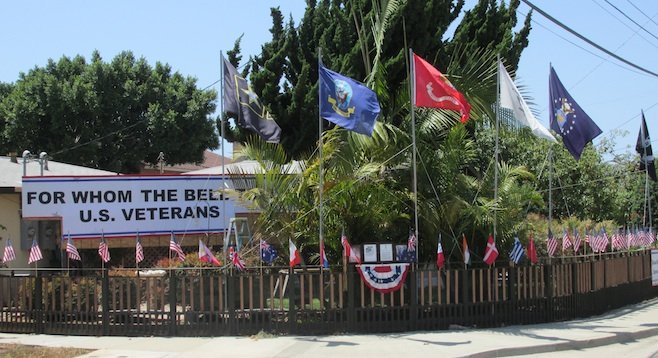 Facebook
Facebook
 X
X
 Instagram
Instagram
 TikTok
TikTok
 Youtube
Youtube

Each year Korean War vet, Vic Caruana, 85, decorates his home for Memorial Day weekend. It’s not hard to miss his house on Harding Street with the 66 American flags, five branches-of-service flags, and his largest flag, one flown in Afghanistan.
When Caruana explains why he spends so much time decorating each year, his eyes well up with tears. “No matter how bad the situation was for us, we made it home. This is for the boys that didn’t come back,” he says.
If Caruana receives any criticism about his display, it’s the questioning of the 12 posted flags from foreign countries. Caruana says these countries were our strongest allies in WWII — Australia, Canada, China, Denmark, England, France, Greece, India, Malta (where Caruana was born), the Netherlands, New Zealand, and the Philippines.
There are two flags he refuses to display — Russia and Brazil. Caruana believes history shows that Russia’s Joseph Stalin was already conspiring with Hitler to divide up Poland before the Nazis attacked Russia. Caruana also says the Russians would not allow American planes to fly over Russian airspace for the Pacific Theater of war.
And of Brazil, Caruana says he once had a Brazilian man stop by to question the lack of a Brazilian flag. Caruana says he told the man, sternly, to “read his history.” Historians acknowledge that Brazil allowed the German submarines to stop over in their ports and provided them with supplies, up until 1942. Pressure from the U.S. eventually forced Brazil to renounce any association with the enemy axis.
Additionally honored in Caruana’s display are pictures and bios of three vets. One is Navy Cross recipient Sgt. Major Anthony Kouma from WWII. Kouma’s son Martin lives across the street from Caruana.
Anthony Kouma’s brother, Master Sgt. Ernest Kouma, was decorated with the Congressional Medal of Honor for his efforts in Korea. A picture shows Kouma receiving the award from President Kennedy. Both of the Kouma veterans are now deceased.
The third display talks glowingly about Dr. Lester Tennety, who, at age 96, still resides in Carlsbad.
At age 21, Tennety was in the 192nd Tank Battalion in WWII. His unit was among the 70,000 American and Filipino prisoners of war who were part of the Bataan Death March — 80 miles of walking, during which Japanese soldiers would kill or behead anyone who fell behind or couldn’t walk anymore. An estimated 15 percent of the solders perished in the march.
Caruana asked his permission to write about and display Tennety’s story three years ago. Caruana was, at first, very strong in his language about Tennety’s capturers. Reportedly, Tennety asked Caruana to tone down his dissertation against the Japanese soldiers a bit, stating, “One has to have a heart.”


Each year Korean War vet, Vic Caruana, 85, decorates his home for Memorial Day weekend. It’s not hard to miss his house on Harding Street with the 66 American flags, five branches-of-service flags, and his largest flag, one flown in Afghanistan.
When Caruana explains why he spends so much time decorating each year, his eyes well up with tears. “No matter how bad the situation was for us, we made it home. This is for the boys that didn’t come back,” he says.
If Caruana receives any criticism about his display, it’s the questioning of the 12 posted flags from foreign countries. Caruana says these countries were our strongest allies in WWII — Australia, Canada, China, Denmark, England, France, Greece, India, Malta (where Caruana was born), the Netherlands, New Zealand, and the Philippines.
There are two flags he refuses to display — Russia and Brazil. Caruana believes history shows that Russia’s Joseph Stalin was already conspiring with Hitler to divide up Poland before the Nazis attacked Russia. Caruana also says the Russians would not allow American planes to fly over Russian airspace for the Pacific Theater of war.
And of Brazil, Caruana says he once had a Brazilian man stop by to question the lack of a Brazilian flag. Caruana says he told the man, sternly, to “read his history.” Historians acknowledge that Brazil allowed the German submarines to stop over in their ports and provided them with supplies, up until 1942. Pressure from the U.S. eventually forced Brazil to renounce any association with the enemy axis.
Additionally honored in Caruana’s display are pictures and bios of three vets. One is Navy Cross recipient Sgt. Major Anthony Kouma from WWII. Kouma’s son Martin lives across the street from Caruana.
Anthony Kouma’s brother, Master Sgt. Ernest Kouma, was decorated with the Congressional Medal of Honor for his efforts in Korea. A picture shows Kouma receiving the award from President Kennedy. Both of the Kouma veterans are now deceased.
The third display talks glowingly about Dr. Lester Tennety, who, at age 96, still resides in Carlsbad.
At age 21, Tennety was in the 192nd Tank Battalion in WWII. His unit was among the 70,000 American and Filipino prisoners of war who were part of the Bataan Death March — 80 miles of walking, during which Japanese soldiers would kill or behead anyone who fell behind or couldn’t walk anymore. An estimated 15 percent of the solders perished in the march.
Caruana asked his permission to write about and display Tennety’s story three years ago. Caruana was, at first, very strong in his language about Tennety’s capturers. Reportedly, Tennety asked Caruana to tone down his dissertation against the Japanese soldiers a bit, stating, “One has to have a heart.”
Comments